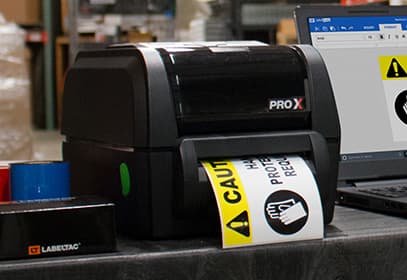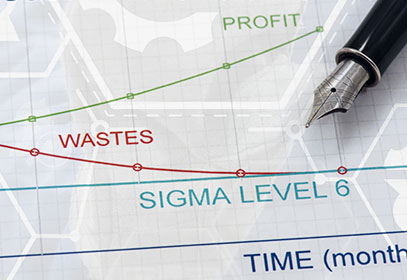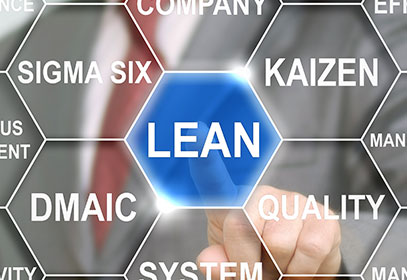Resources
The tools and techniques of Six Sigma work to get manufacturers as close as possible to running a production with zero defects, ensuring only quality products are created.
Six Sigma was developed in the 1980s by a Motorola engineer. It is based on statistics and influenced by Japanese business practices. While Six Sigma practitioners and professionals have differences in opinion when it comes to what exactly Six Sigma is, almost everyone can agree on the basics:
- Metrics: Statistics are at the heart of Six Sigma – even the name comes from statistical process terminology. A ‘Six Sigma process' is a manufacturing process that allows just 3.4 defects per one million opportunities; in other words, the manufacturing process is operating at a 99.99966% yield.
- Tools: Charts and diagrams fill up a good portion of the Six Sigma toolbox. Examples include process maps, value stream maps, control charts, fault tree analyses, and much more.
- Philosophy: In Six Sigma, work can be classified as processes and the variation within these processes can be continuously measured and improved, thus increasing the percentage of defect-free products.
- Methodology: Six Sigma projects are carried out using either DMAIC or DMADV. DMAIC is the most widely adopted approach for continuously identifying problems and implementing solutions that will stick.
Six Sigma and Lean manufacturing are often mentioned in the same capacity – there's even a methodology called Lean Six Sigma! And while it's true that both methodologies have the same goal, creating quality products at the best possible cost for customers, each utilizes different approaches to get there. Whereas Lean uses tools and strategies to eliminate waste and streamline efficiency, Six Sigma is focused on eliminating defects and reducing variation within processes.
As partners dedicated to helping you improve your facility and business, Creative Safety Supply offers an expansive library of Six Sigma resources. Whether you're considering a Six Sigma initiative or just need some help before a Six Sigma project, we're here to help.
Getting Started
- Confused with industry jargon? Check out our Lean glossary.
- Want to learn more about Lean manufacturing? Explore our Lean resources.
- Have a question about Six Sigma? Browse our Six Sigma Q&A hub.
- Ready to get started? Shop our selection of Lean supplies.
Six Sigma Articles
Control Charts: A Basic Component of Six Sigma
Statistical process control charts are a helpful visualization tool for recognizing deviation within a process. These charts help operators know when to take action. …
John Krafcik and the Birth of the Term Lean
Learn all about where the term Lean came from in this article! You’ll read about John Krafcik and his initial studies on Lean production methods. …
Understanding the SIPOC Diagram in Six Sigma
Creating a SIPOC diagram to determine the Suppliers, Inputs, Process, Outputs, and Customers of an operation can help businesses achieve improvement and ensure Six Sigma success. …
Understanding Design for Six Sigma (DFSS)
DFSS is an improvement technique that uses the DMADV approach to ensure that a product or service meets customer expectations as it is originally introduced to the market. …
Quality Control
Quality Control helps ensure products are meeting customer needs and reduce the risk of product defects. Let this article help get you started. …
DMAIC Cycle
The DMAIC cycle is the foundational method of Six Sigma, the Lean manufacturing method that radically reduces defects in production and infinitely improves efficiency. Learn how to implement Six Sigma into your facility with DMAIC. …
Safety Committee
Implementing a safety committee can help improve the overall safety of your company. Discussing safety concerns and resolving them will keep your employees safe. …
Quality Control in Manufacturing
Quality control in manufacturing is essential to maintaining a good customer base and keeping rework costs down. …
Six Sigma Certification
Are you wanting to learn more about Six Sigma certification? Review this basic information on what it takes to become Six Sigma certified. …
What is QCDSM?
QCDSM: Quality, Cost, Delivery, Safety and Morale. Learn how this simple lean principle can help your business. …
8 Wastes of Lean [A Guide to Manufacturing Wastes]
The 8 Wastes of Lean is a much-needed update to the what the Toyota Production System called the 7 Wastes of Lean. Fighting these wastes head on will help your facility run more smoothly and efficiently. …
Six Sigma Belt Levels [Hierarchy of Certification]
Have you ever wondered what the Six Sigma belt levels are? Learn the requirements for each belt level and what it will do for your organization. …
Supply Chain Integration
Supply chain integration refers to the process of integrating all parts of fulfillment into one single system. Learn the steps to get your supply chain integrated into an easy-to-manage system. …
What is a thermal printer? (direct transfer)
Thermal printers are essential to printing in an industrial setting. Learn about the two types of thermal printing to determine which one suits your facility’s needs. …
Six Sigma Black Belt
For people wanting to master the six sigma methodologies, earning six sigma belts is the best way to master the principles associated with Six Sigma. …
Six Sigma Green Belt
Earning a Six Sigma green belt is the first step toward mastering Six Sigma methodologies. Learn how to get started here. …
Six Sigma Principles
Find out how to properly implement six sigma principles to promote success in your business. …
5 Lean Principles for Process Improvement
Learning the basics about the lean process is essential when implementing continuous improvement changes. We have broken down the lean process so its easy to understand. …
Continuous Improvement (A Kaizen Model)
Facilities that focus on continuous improvement become more competitive over time and can maintain their advantages in their industry, but only if the improvement efforts are done correctly. …
Six Sigma Questions and Answers
What does VOC stand for?
VOC stands for Voice of Customer or Voice of Client which is mentioned in the define phase of the Six Sigma DMAIC process. It is essentially the customer’s overall opinion of the product including their expectations, preferences, and comments that assists companies in creating a product that meets or exceeds the customer’s expectations. The first thing… …
What is DFMEA?
DFMEA is an acronym for Design Failure Mode and Effects Analysis, a Six Sigma tool that helps to determine potential failure in a system, product, or process. It also identifies the underlying cause behind these failures, and what the consequences may be when they occur. When it’s used correctly, DFMEA can protect a business’s reputation,… …
What does SPC stand for?
SPC stands for Statistical Process Control. It is a methodology that is widely used to continuously improve processes, and is a subset of Six Sigma. Six Sigma, one of the major techniques of Lean manufacturing, aims to prevent process variation and make sure that a company has the ability to consistently and reliably produce products… …
What is FMEA?
A FMEA is a failure modes and effect analysis. “Modes” are the ways that a process or product may go wrong. This type of analysis is a useful tool for identifying problems that may occur, as well as the potential impact of these problems. In fact, it’s regarded as one of the best ways to… …
What is DMAIC?
DMAIC is an acronym that stands for, “Define, Measure, Analyze, Improve, and Control.” It is a popular improvement cycle that is used in many business environments. One of the most common places where DMAIC is used is in Six Sigma projects. These projects look to make improvements on products, reduce waste, and improve the way… …
What is a Pareto chart?
A Pareto chart is a popular way to display information that uses both bars and lines. In these charts, the individual numbers on the graph are represented by the bars, and then the cumulative totals are represented by the lines. This type of chart is especially popular in project management, though they have been used… …
Who needs a Six Sigma certification?
If you are attempting to improve your career outlook, you may be thinking about trying to get some type of certification for your resume. For many people, a Six Sigma certification is an ideal option. Six Sigma offers a number of different levels of certification that are designed for various types of jobs or roles… …
What is the main goal of implementing Six Sigma?
Most people have heard of Six Sigma, and many have even used the tools or strategies in their roles in the workplace. When a company decides to implement Six Sigma, it is important that everyone involved understands what the main goal of this process is going to be. Six Sigma is not simply a program… …
What companies use Six Sigma?
Six Sigma strategies are used by thousands of companies around the world. Even those that don’t officially state that they use these concepts often have them as an important part of their day to day activities. This could be because they just informally adopt them, or because they have Six Sigma certified employees working, who… …
What is the Six Sigma green belt?
Six Sigma training is important for helping to reduce waste in the workplace, improve quality, and meet customer expectations. Anyone who wants to work in a Six Sigma environment should work toward attaining the correct certification level for their role. Each certification level comes with a different color belt, similar to what one would see… …
Who developed Six Sigma?
Six Sigma was originally developed (in its modern form) by Bill Smith, who is an engineer who was working at Motorola at the time. The development process started in 1980 and continued over the course of about a decade. Mr. Smith is typically considered the co-founder, along with Dr. Mikel J Harry, though most of… …
Is a Six Sigma certification worth it?
When an individual is looking for ways to improve their job prospects they will often turn to additional education, degrees, experience, and certifications. For many people, pursuing a Six Sigma certification is going to be at the top of their list of goals. It is important to ask, however, whether or not a Six Sigma… …
Is Six Sigma just a fad?
There are many different business strategies and improvement programs that become popular for a time, and then fade into obscurity over time. This leads some people to wonder if Six Sigma is just a fad, or if it will remain a popular strategy long into the future. Interestingly, this is a question that has been… …
What is the Six Sigma Black Belt?
In the Six Sigma program there are multiple different levels that one can attain. These levels follow a similar standard as one would find in martial arts, with different colored belts. For most people, the highest level that they will need to attain is going to be the black belt. There is also a master… …
Is Six Sigma worth it?
Getting a Six Sigma certification is a lot of work, especially if you want to get one of the higher-level belts. Many people wonder if Six Sigma is worth the effort. This can really be looked at in two separate ways. First, is Six Sigma worth it for employees, and then second, is Six Sigma… …
How can employees become Six Sigma certified?
If you want to improve the way your company operates, it can be very helpful to start implementing Six Sigma tools and strategies. In order to do this, you will want to make sure some of your employees become Six Sigma certified. Fortunately, this is not a terribly difficult process, though it will take some… …
What is the history of Six Sigma?
Six Sigma is a popular set of techniques and tools used to improve processes within the workplace. It was first developed in 1980 by Bill Smith. Smith was an American engineer who worked for Motorola at the time. Understanding the history of Six Sigma is a good way to learn more about these processes, how… …
Why is Lean Six Sigma important?
Lean Six Sigma is a very popular topic in businesses around the world today. It gets so much attention, some people assume it is just a ‘buzz word’ that is popular at the moment but will fade out over time. The reality, however, is that the Six Sigma strategies have been around for quite some… …
What is CTQ?
CTQ is a concept that is commonly used in Six Sigma. It is an acronym, which stands for ‘critical to quality.’ When it comes to manufacturing and other industries, understanding which aspects of a product are critical to its overall quality. This will help a company determine what features must be there, and which ones… …
When was Six Sigma developed?
Six Sigma was first established in the 1980s, by a team of consultants that were hired to help improve quality at Motorola. The story of Six Sigma’s origin started in a place where good stories rarely begin: a board room, in a manager’s meeting. In the eighties, a group of Motorola executives were discussing, among other things,… …
What is Six Sigma certification?
Six Sigma certification is a way for individuals to improve their knowledge and experience with the quality management philosophy known as Six Sigma. Certification puts an emphasis on both knowledge and application so that people will be experienced enough to apply Six Sigma in the workplace. There are several levers of certifications available to work… …
How is Six Sigma different from Kaizen?
There are many similarities between Six Sigma and Kaizen, but ultimately, what makes them differ is that Six Sigma is built to improve one specific area, which is quality of product/services provided. Kaizen is a more general, since its goal is to have companies strive toward continued improvement across the board. Six Sigma’s goal is… …
Who can do Six Sigma?
There aren’t technically any legal requirements to practice Six Sigma. Six Sigma isn’t like medicine, counseling, or private investigation; there’s no license required or permit to request to become a Six-Sigma facility. Still, to implement and sustain Six Sigma successfully, you’ll want a Six Sigma expert to lead the charge. Six Sigma requires a significant education on… …
What is required for Six Sigma certification?
For Six Sigma certification, study and experience is required. There are various ways to get started on the path toward earning Six Sigma belts. For more information, visit here. Six Sigma certification is broken down using the belt system. The levels of the system are broken down like this: white belt, yellow belt, green belt, black… …
What are the benefits of Six Sigma?
There are many benefits to Six Sigma. This Lean method works to rid your facility of one of the costliest wastes: defects. Defects plague manufacturing businesses because defective products cost companies in both expensive resources and workers’ time. Bill Smith, one of the engineering consultants that helped create Six Sigma, understood that the key to… …
How can Six Sigma help a company?
Six Sigma can help companies become more productive, effective, lucrative and efficient by eliminating waste and streamlining processes. Six Sigma helps eliminate one of the costliest wastes of manufacturing: defects. If you haven’t heard of them before, Lean manufacturing identifies the following as the 8 Wastes of Lean: Defects - products or services that don't meet company… …
Can Six Sigma be implemented everywhere?
Since Six Sigma doesn’t require any special equipment or conditions for implementation, it can be implemented everywhere and anywhere. Six Sigma methods aren’t restricted by manufacturing size, numbers of employees, or scale of operation. Whether you’re a multi-national corporation with dozens of manufacturing facilities scattered across six continents or a local, twenty-five-employee sausage factory, Six… …
Can Six Sigma be used in service industries?
This is a great question. For most, Six Sigma seems like its uses and advantages would only benefit industrial manufacturing, since its intended purpose is to improve mass production processes and greatly reduce the chances of inconsistencies (3.4 per million production cycles, to be exact). But businesses that focus on manufacturing aren’t the only ones… …
What are Six Sigma principles?
In a nutshell, these three elements encompass the following principles: Six Sigma aims to make continuous improvements to production. It believes stable and predictable production results are crucial to sustaining success in the long-term. Manufacturing processes can—and need to be—measured, analyzed, and controlled. In order for Six Sigma to succeed in a company, company-wide effort,… …
What are the five different Six Sigma belts?
Six Sigma certifications are measured using the martial-arts inspired belt system: white, yellow, green, black, and master black. White Belt Note: this belt isn’t actually a certification The white belt is a more informal designation than the other belts, since it doesn’t actually count toward actual certification. This belt is for anyone interested in completing Six Sigma certification—it’s… …
How can Six Sigma be used in project management?
Six Sigma can absolutely be used for project management. In fact, this method is best used in small, scalable projects that produces data and results easily collected, controlled, and analyzed by project managers. In order for project managers to successfully implement Six Sigma, though, they will need a significant amount of information on Lean methods and… …
Is Six Sigma Lean?
Yes, Six Sigma is a Lean manufacturing method that focuses specifically on quality control and quality management. Six Sigma uses a number of foundational Lean methods to establish its principles. In fact, Six Sigma’s whole purpose is to combat defects, which is one of the 8 Wastes of Lean: Defects, Overproduction, Waiting, Non-utilized talent, Transportation,… …
What is Six Sigma?
Six Sigma is a quality-management strategy meant to reduce defects and thus minimize the need for rework. Its goal is to decrease the chance of deviation as much as possible. More specifically, Six Sigma aims to have fewer than 3.4 defects per million production cycles. In a nutshell, these three elements encompass the following principles: Six… …









![8 Wastes of Lean [A Guide to Manufacturing Wastes]](https://www.creativesafetysupply.com/content/images/articles/8-wastes-th.jpg)
![Six Sigma Belt Levels [Hierarchy of Certification]](https://www.creativesafetysupply.com/content/images/articles/six-sigma-belt-levels-th.jpg)












